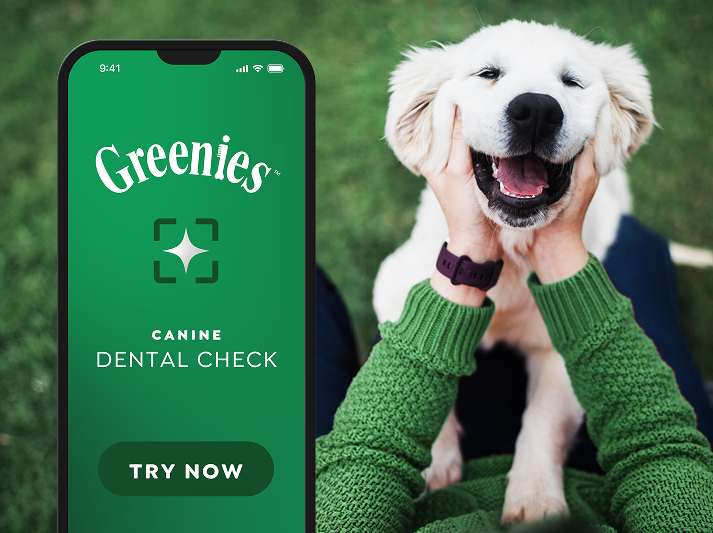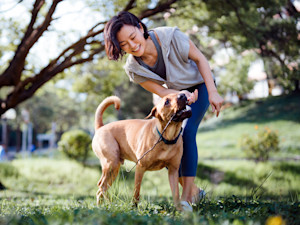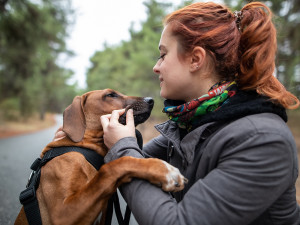Are Essential Oils Safe for Your Dog?
Understand the risks.
In This Article:
What Are Essential Oils? Can You Use Essential Oils for Your Dog? Which Essential Oils Are Safe for Dogs? Which Essential Oils Are Bad for Dogs? Identify Essential Oil Poisoning in Dogs How to Safely Use Essential Oils with Dogs
Essential oils have grown significantly in popularity over the past few decades. Many manufacturers and retailers claim that these oils do more than smell nice. Some potential benefits include improvement in mood, sleep, and even appearance.
Some companies have even suggested that essential oils can treat medical issues. Due to these potential benefits, many dog parents want to use essential oils on their dogs to improve their sleep, soothe their anxiety, or treat their medical issues. But before considering any possible benefits, we have to ask: Are essential oils safe for dogs?
Snap a pic of your pup’s teeth, and GREENIES™ will help you spot potential signs of oral health issues.
How much do you spend on your pet per year?
What are essential oils?
Essential oils are a distillation of the oils and chemicals from plants that give them their characteristic scent. These oils are called “essential” because they contain the “essence” of a plant’s fragrance; they are not essential to life for people, plants, or animals. These oils come in a variety of concentrations and formulations. While essential oils are often sold as single-source concentrates for alternative therapies, multiple oils are sometimes combined into one product in commercial formulations.
Essential oils are commonly found in cosmetic products due to their pleasant aroma and purported effects on skin health. In people, peppermint oil may give some relief to people with gastrointestinal upset, lavender oil has been shown to improve sleep quality, and tea tree oil has benefits for acne. Though the basis for these claims is often murky, essential oils have also been promoted as treating numerous other human health problems, including:
Asthma
Eczema
Bacterial infections
Inflammatory conditions
Gassiness
Toothaches
Intestinal cramping
Depression
While some people may benefit from using essential oils for these issues, the science is not clear on the true effects of the oils.
Can you use essential oils on your dog?
The benefits of essential oils for people are still hotly debated due to conflicting evidence about their effectiveness, and the data for dogs is even more lacking. Dogs do not seem to be as sensitive to the toxic effects of essential oils as cats (cats and essential oils do not get along). But essential oil toxicosis has been reported in numerous dogs. Due to the risk of exposure by contact, inhalation, or mutual grooming, definitely avoid using essential oils on your dog if you have cats in the house.
As with most things, whether essential oils are poisonous depends on the dose. Dogs may tolerate diluted versions of certain oils, but toxic or irritant effects may become evident as the concentration of the oil increases. This brings up another important issue that I discuss with pet parents when they’re considering using essential oils for their dog: product quality and consistency. Essential oil production has become a huge industry, and most products within it are unregulated.
Depending on the study, somewhere between 50 and 80 percent of essential oil products do not contain the oils they are labeled with in the concentrations they claim. Difficult-to-produce oils are often cut with lower-quality ingredients. This makes tracking product safety and effectiveness very difficult.
Another issue with using essential oils on dogs relates to their very reason for existing: their aroma. Dogs have incredible noses that they use to navigate the world around them. Overloading their primary-sense organ with an overpowering scent is likely disorienting and unpleasant. Ever get spritzed with a perfume that you didn’t like? Imagine walking around with that all day while having a super-sensitive sense of smell.
Which essential oils are safe for dogs?
It’s difficult to give a definitive answer about which essential oils are safe for dogs. Again, the dose makes the poison, and unregulated essential oil products are unreliable enough that it’s difficult to determine the dose. Long-term studies of the safety of essential oils in dogs are lacking, making it difficult to know if regular use of these products is safe.
According to the ASPCA’s Animal Poison Control Center, even topical essential oil products meant to treat and control fleas in dogs have caused issues. Flea sprays, shampoos, and spot-on products containing less than five percent concentrations of essential oils like peppermint, cinnamon, lemongrass, clove, rosemary, cedarwood, and thyme have caused problems, including death.
With all the uncertainty about the safety, concentration, and composition of essential oil products, I generally do not recommend their use in dogs unless prescribed by a veterinarian. For me, the safety concerns outweigh the potential benefits, especially when considering concentrated oils.
Which essential oils are bad for dogs?
Some essential oils are especially notorious for causing problems in dogs. Oils known to cause toxicity issues in dogs include:
Tea tree oil (also called melaleuca oil)
Pennyroyal oil
Oil of wintergreen
Oil of sweet birch
Pine oil
Cinnamon oil
Eucalyptus oil
Clove oil
Hyssop oil
Peppermint oil
Essential oils can be inhaled, absorbed through the skin, or ingested. Each essential oil can cause its own set of problems for dogs. The route of exposure can affect the amount absorbed and speed of absorption. Don’t assume that a dog will only develop symptoms if they’ve ingested an essential oil. Because of their chemical structure, many of these oils absorb rapidly through the skin, and dermal exposure alone has caused toxicities.
Identify essential oil poisoning in dogs
Because there are so many essential oils out there, the symptoms of essential oil poisoning vary greatly. If your dog is acting abnormally after being exposed to an essential oil, contact your veterinarian or an animal poison control center. They can help you determine if the essential oil is the culprit and figure out a plan for decontamination and treatment.
Some common symptoms of essential oil poisoning in dogs include:
Diarrhea
Drooling
Seizures
Pale gums
Local skin irritation
Altered behavior (seeming dull or out of it)
Loss of balance
Muscle tremors
Elevated or decreased body temperature
Coma
How to safely use essential oils with dogs
If you’re using essential oils in your house, it’s important to take precautions to protect your dog from exposure. Always keep essential oils in an area that your dog cannot reach. Even if your dog doesn’t lick them up, spilled essential oils still pose a hazard.
Essential oils are often used in diffusers (either passive or active), oral products, and spot-on products. There are no good studies about long-term exposure to essential oils in dogs, so it’s hard to say with certainty what kind and amount of exposure is safe.
Essential oils in passive diffusers, like reed diffusers, candles, or heated bowls, are likely safest for dogs without breathing issues. These diffusers basically have the volatile components of the oil evaporate into the air. The strong scent may bother some dogs and cause watering of the eyes or avoidance of the area but seems unlikely to produce short-term toxic effects.
Active diffusers, which use pressure to disperse microdroplets of essential oil into the air, may cause more problems. These tiny droplets may be small enough to be inhaled deep into the lungs, where they can cause inflammation and irritation. They can also land on a dog’s coat where they can be licked off, absorbed, or cause local irritation.
Feeding a dog concentrated essential oils is not recommended. While there has been some testing done using essential oils as a preservative in dog food, the safety of ingesting essential oils in dogs is not well established.
Why you should never apply essential oils to your dog’s coat
Essential oils are hydrophobic, which makes them particularly good at being absorbed across the skin. Don’t assume that an essential oil will just stay on the surface of your dog’s skin and only be active there. Essential oils move rapidly into fatty and nervous tissue, which is why some of their most common adverse effects are neurological.
Final thoughts
Although essential oils are touted as being beneficial in treating many conditions, the evidence for their use in dogs is poor. Due to the poor quality control in commercial products and the toxicity of many essential oils, using essential oils in or around dogs is not recommended. In addition to the potential toxic effects of the oils, their strong scent is likely overwhelming for dogs’ sensitive sense of smell.
References
Barak, Timur Hakan et al. “Evaluation of Marketed Rosemary Essential Oils (Rosmarinus officinalis L.) in Terms of European Pharmacopoeia 10.0 Criteria.” Turkish journal of pharmaceutical sciences vol. 20,4 (2023): 253-260. doi:10.4274/tjps.galenos.2022.78010opens in new tab.
Capetti, Francesca et al. “Adulteration of Essential Oils: A Multitask Issue for Quality Control. Three Case Studies: Lavandula angustifolia Mill., Citrus limon (L.) Osbeck and Melaleuca alternifolia (Maiden & Betche) Cheel.” Molecules (Basel, Switzerland) vol. 26,18 5610. 16 Sep. 2021, doi:10.3390/molecules26185610opens in new tab.
Genovese, Allison G et al. “Adverse reactions from essential oil-containing natural flea products exempted from Environmental Protection Agency regulations in dogs and cats.” Journal of Veterinary Emergency and Critical Care vol. 22,4 (2012): 470-5. doi:10.1111/j.1476-4431.2012.00780.xopens in new tab.
Gómez-García, Manuel et al. “In vitro activity of essential oils against microbial isolates from otitis externa cases in dogs.” Natural product research vol. 36,17 (2022): 4552-4556. doi:10.1080/14786419.2021.1993217opens in new tab.
Khan, Safdar A et al. “Concentrated tea tree oil toxicosis in dogs and cats: 443 cases (2002-2012).” Journal of the American Veterinary Medical Association vol. 244,1 (2014): 95-9. doi:10.2460/javma.244.1.95opens in new tab.
Means, Charlotte. “Selected herbal hazards.” The Veterinary Clinics of North America. Small Animal Practice vol. 32,2 (2002): 367-82. doi:10.1016/s0195-5616(01)00009-2opens in new tab.
Pokajewicz, Katarzyna et al. “Lavender essential oil market integrity: A comprehensive study of commercial Lavandula angustifolia essential oils adulteration and assessment of industrial standards” Industrial Crops and Products vol. 222,3. 15 Dec. 2024, doi:10.1016/j.indcrop.2024.119744opens in new tab.
Tadee, Phacharaporn et al. “Essential oil pharmaceuticals for killing ectoparasites on dogs.” Journal of Veterinary Science vol. 25,1 (2024): e5. doi:10.4142/jvs.23189opens in new tab.
Villar, D et al. “Toxicity of melaleuca oil and related essential oils applied topically on dogs and cats.” Veterinary and Human Toxicology vol. 36,2 (1994): 139-42.
Woolf, A. “Essential oil poisoning.” Journal of Toxicology. Clinical Toxicology vol. 37,6 (1999): 721-7. doi:10.1081/clt-100102450opens in new tab.











